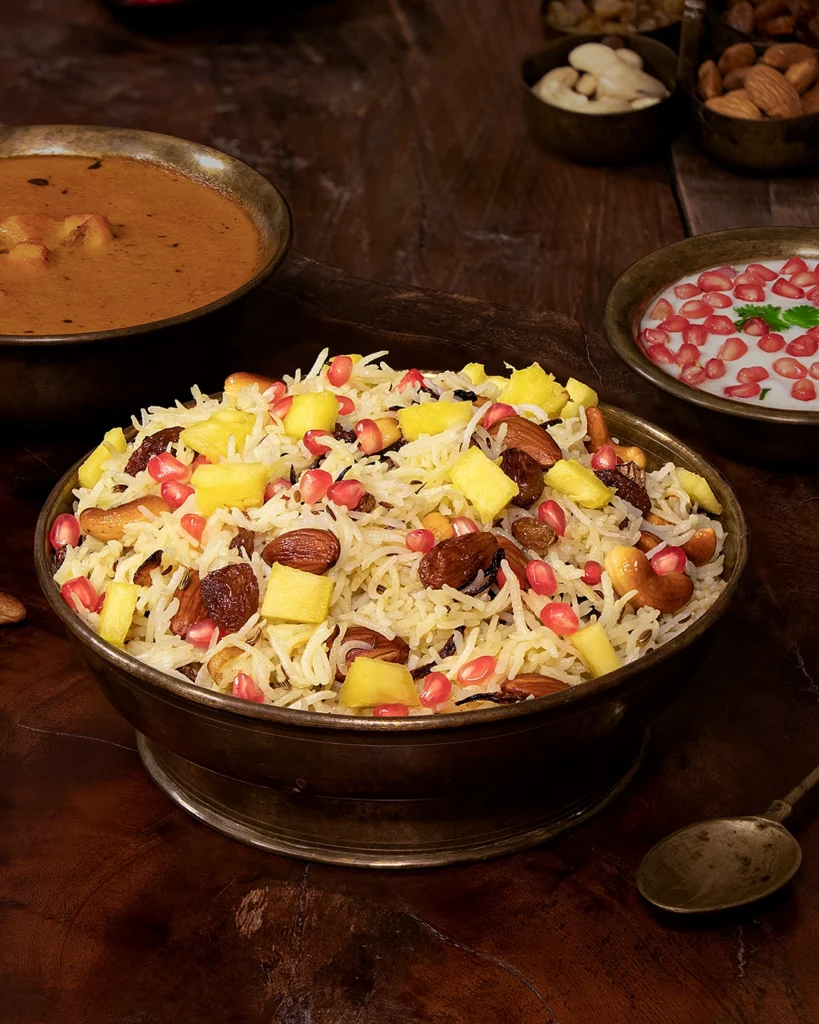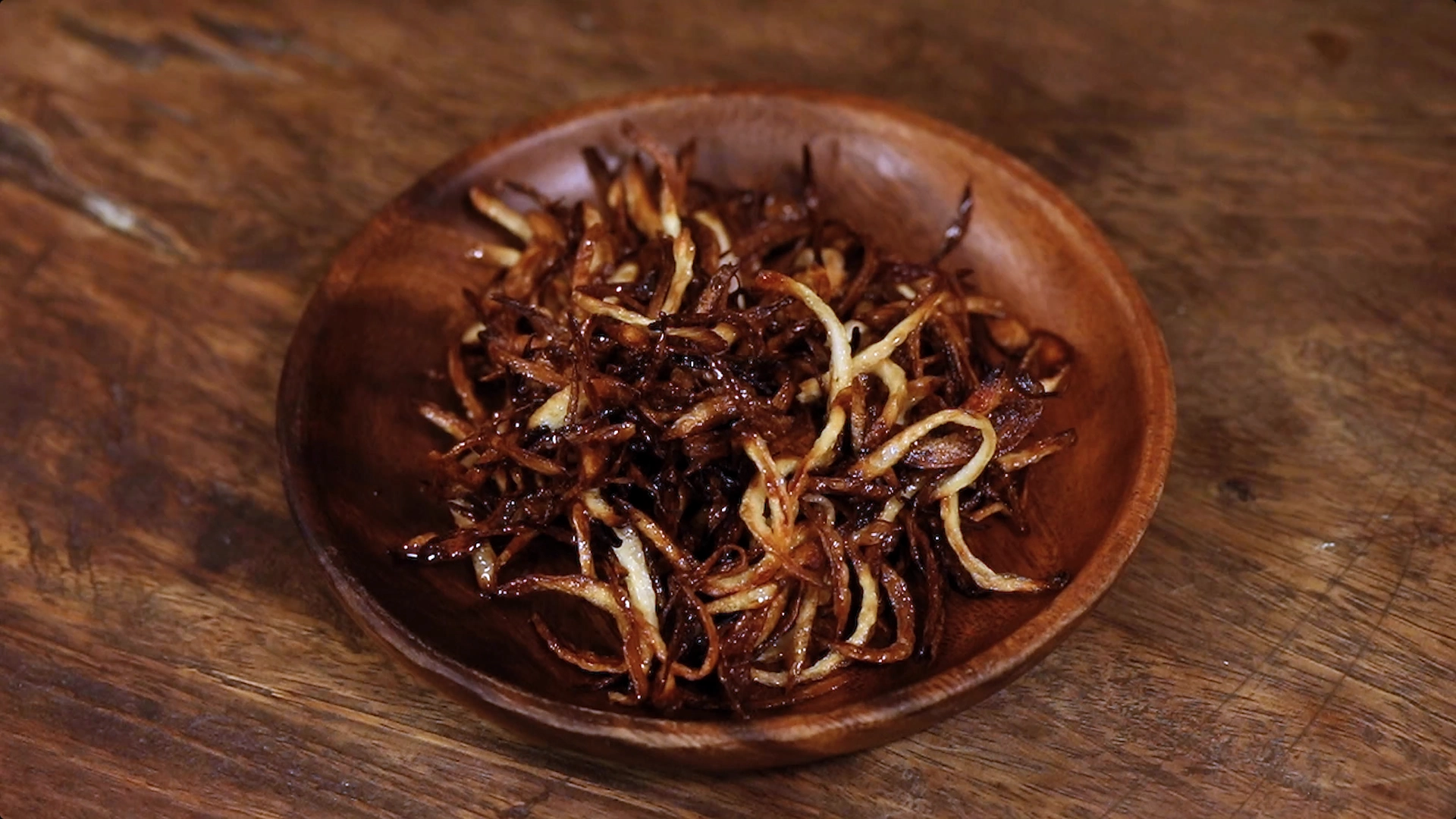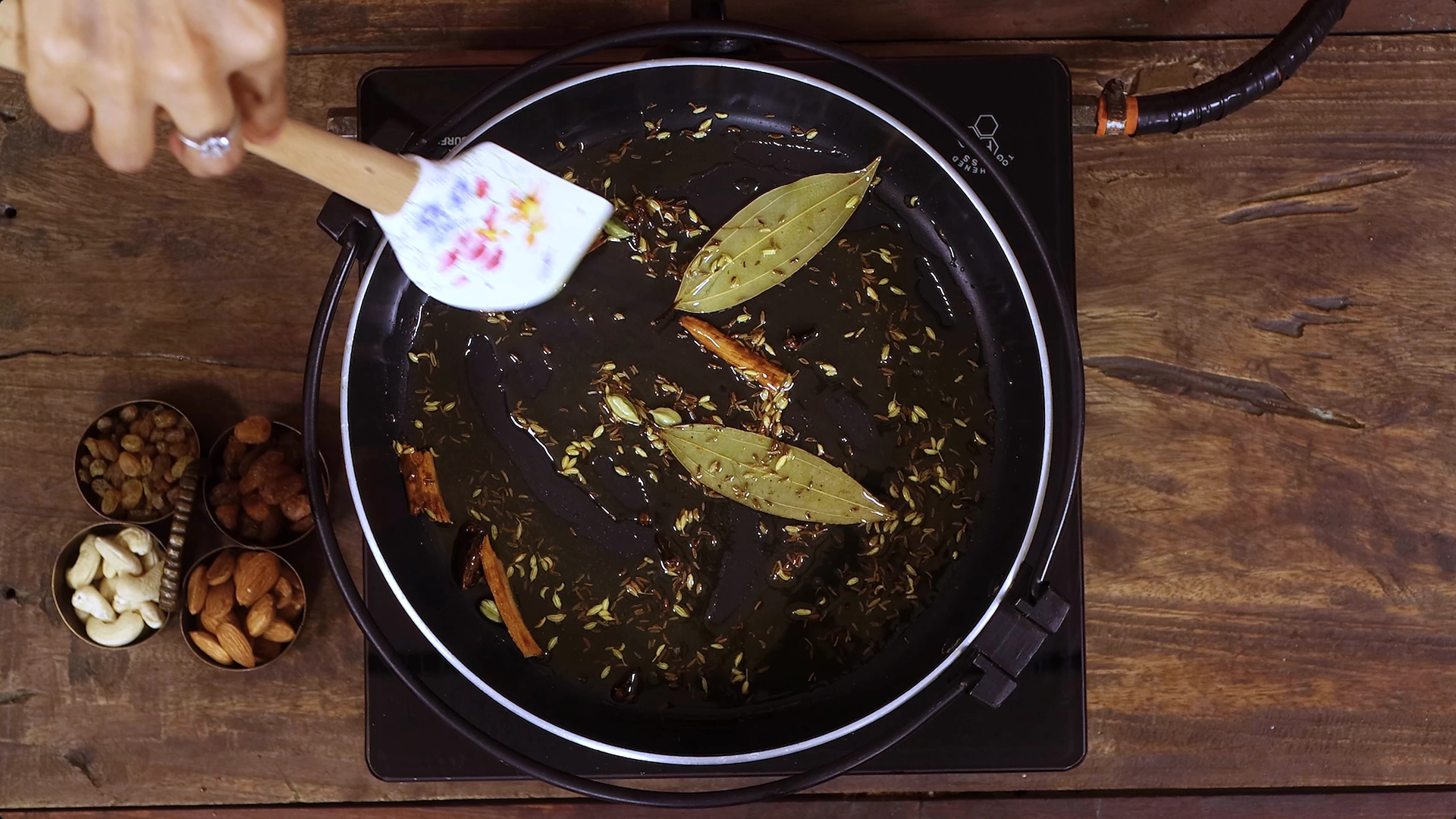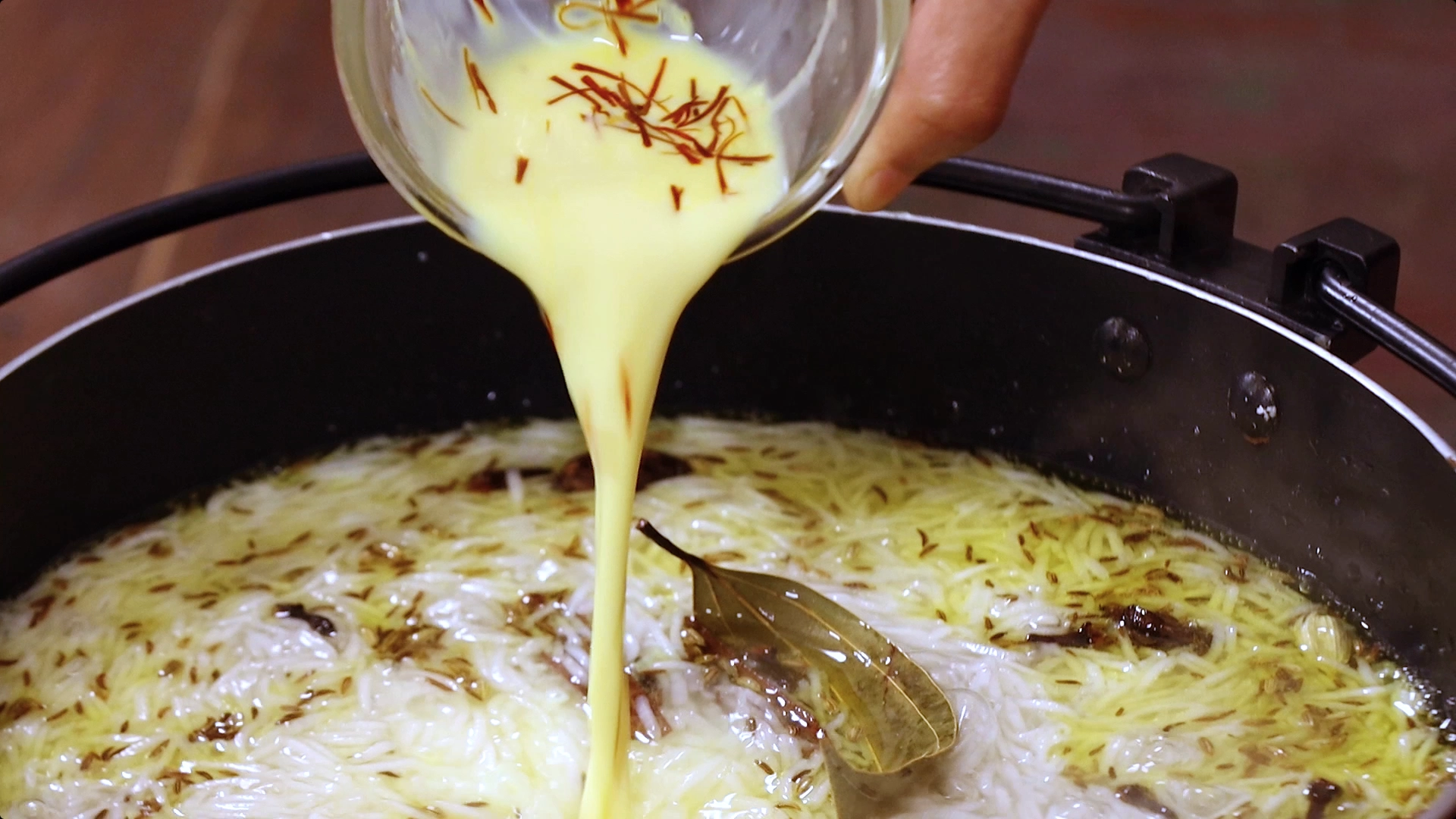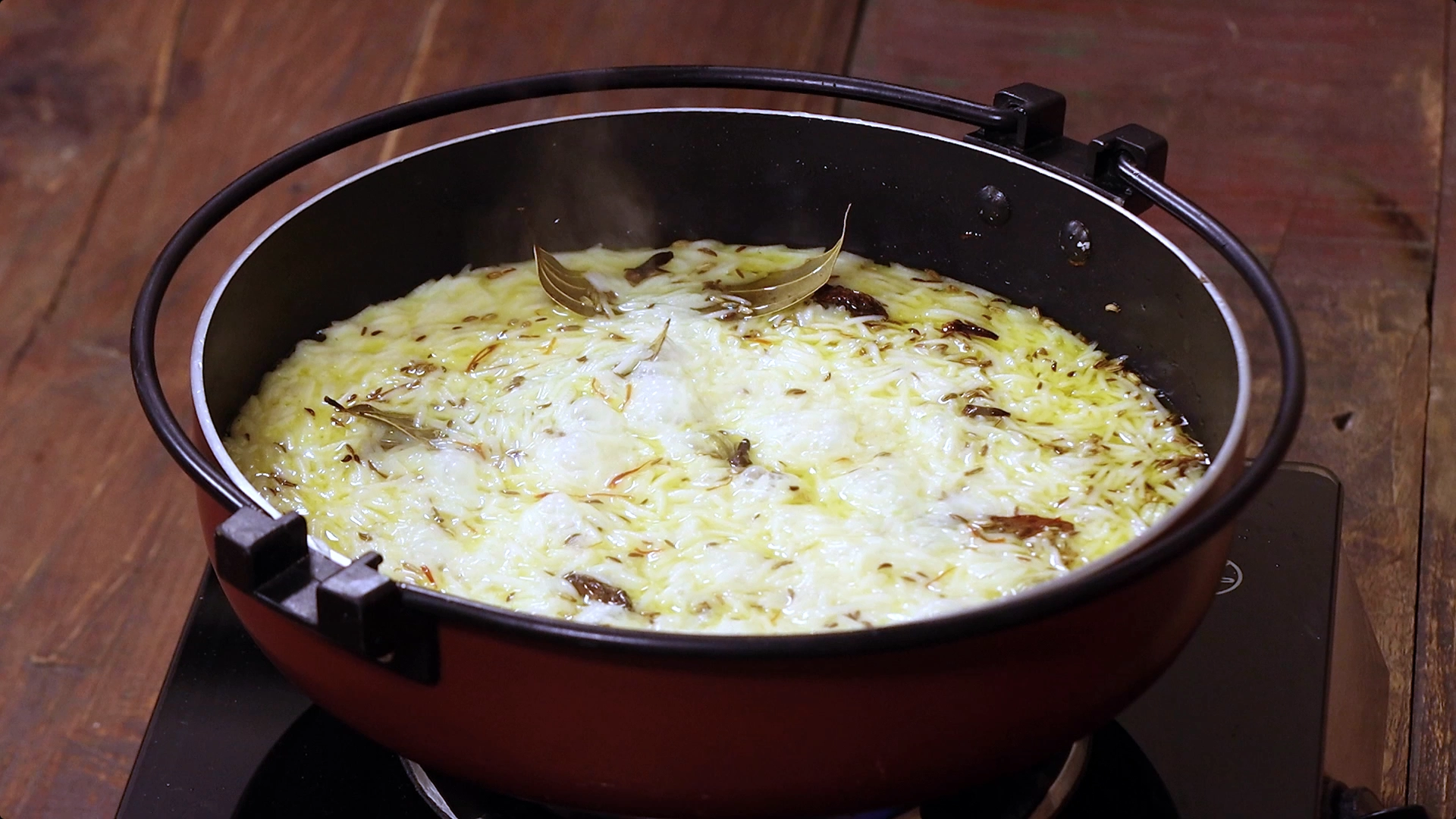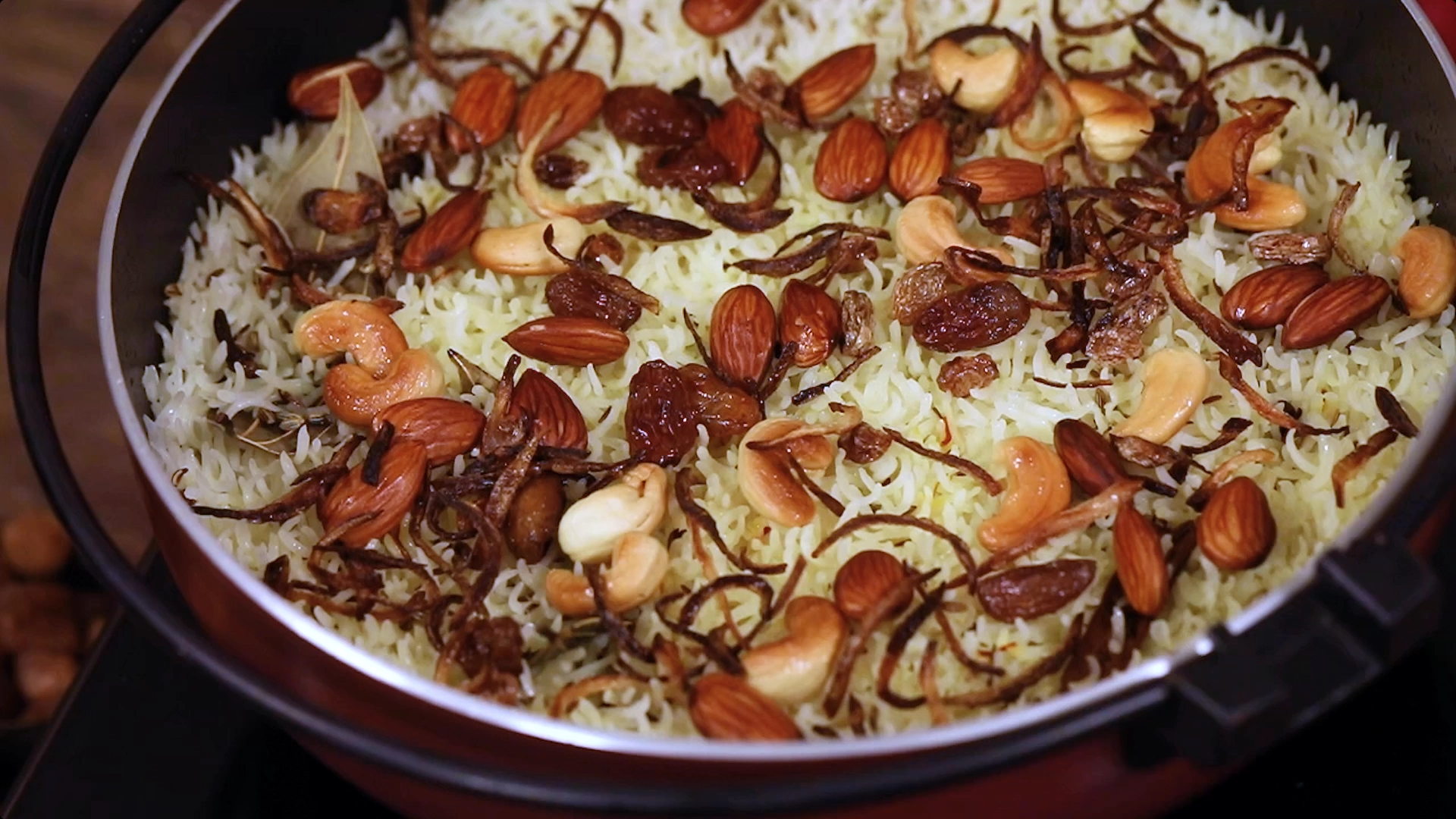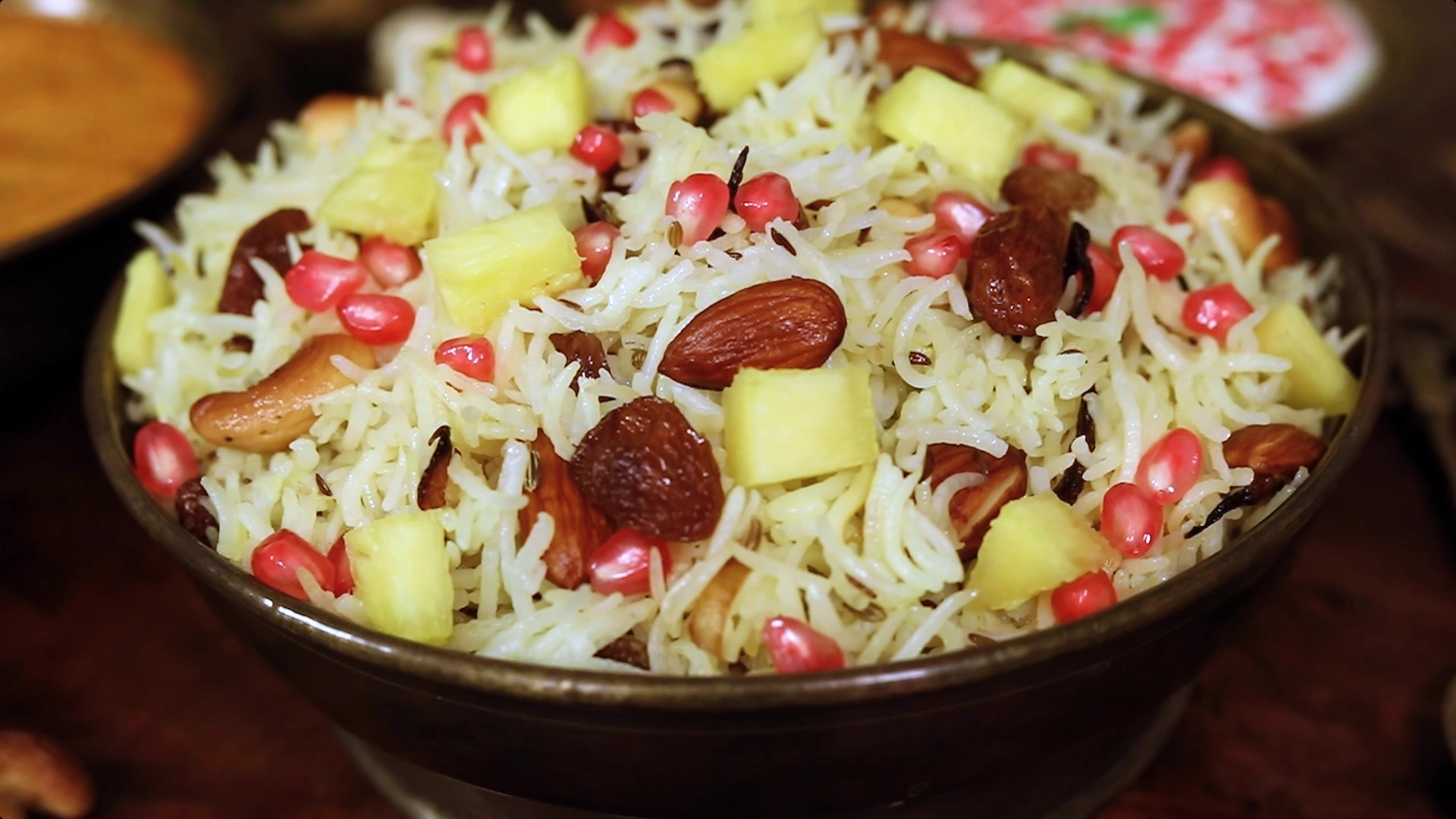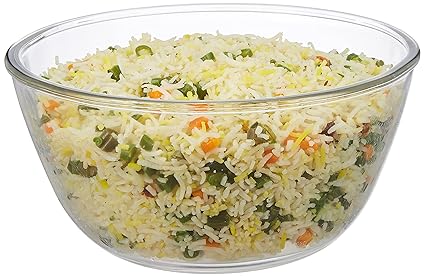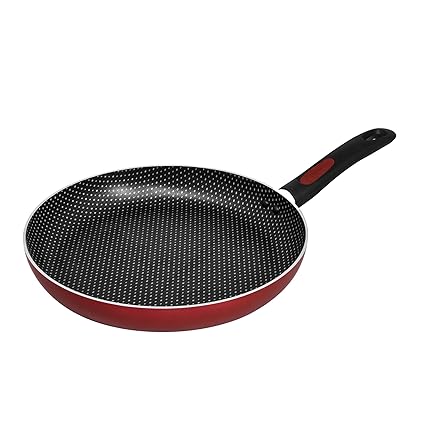If you’ve ever wanted a dish that looks festive, tastes incredible, and is still unbelievably easy to make, Kashmiri Pulao is exactly what you need. This aromatic, mildly sweet rice dish from the valleys of Kashmir is loaded with nuts, dry fruits, and sometimes even fresh fruits—giving every bite a rich, royal feel.
Unlike the usual spicy pulao, this one leans into warm sweetness and delicate flavours. It’s the kind of dish that instantly upgrades your table, whether you’re cooking for a special celebration or simply treating yourself to something a little luxurious.
A Little Backstory
Kashmiri Pulao comes from the stunning valleys of Kashmir, a land famous for its breathtaking landscapes and rich food culture. This dish isn’t just a simple rice preparation—it’s a reflection of Kashmir’s royal history and Persian-Mughal influences. Back in the day, Kashmiri Pulao was a favourite at royal feasts, where it was served with dry fruits, nuts, and the region’s prized saffron, making it a dish of pure indulgence.
Now, let’s talk about the larger Kashmiri food culture—because if you love good food, you’re going to love what Kashmir has to offer!
Kashmiri cuisine is broadly divided into two main styles
- Kashmiri Pandit Cuisine – This is a purely vegetarian fare developed by Kashmiri Pandits. Unlike most Indian food, it uses minimal onions and garlic but relies on aromatic spices like fennel, dry ginger, and cardamom to build deep flavors. Kashmiri Pulao belongs to this cuisine, making it a beloved dish among Pandits.
- Wazwan Cuisine – This is the grand, non-vegetarian feast of Kashmir, known for its slow-cooked, meat-heavy dishes like Rogan Josh, Yakhni, and Goshtaba. While Kashmiri Pulao itself is vegetarian, it pairs beautifully with these Wazwan delicacies, balancing out the rich flavors of the meat curries.
So, whether you’re a vegetarian food lover or someone who enjoys meat, Kashmiri Pulao fits right in—either as a comforting rice dish on its own or as the perfect main dish to a lavish Wazwan side dish
Ingredients & How to Buy the Best
To make the most delicious Kashmiri Pulao, you need top-quality ingredients. Here’s how to pick the best ones and some smart buying tips
Basmati Rice
A good long-grain basmati rice is what gives Kashmiri Pulao its signature fluffy texture and aroma.
- How to select: Look for extra-long grain varieties —these give the best fragrance. The grains should be slender, separate, and not broken.
- Pro tip: The older the basmati, the better the aroma! Aged basmati (1-2 years old) has lower moisture content, making it fluffier when cooked.
Saffron
Saffron adds color, aroma, and a rich taste, making it an essential ingredient in Kashmiri cuisine. But since saffron is expensive, many fake or low-quality versions flood the market.
How to Test Saffron’s Authenticity
- Take a few saffron strands and drop them in warm water or milk. Real saffron takes 10-15 minutes to release a deep golden hue. Fake saffron colors the water instantly.
- Rub a strand between your fingers. If it feels smooth and not crumbly, it’s the real deal.
- Authentic saffron smells like a mix of honey and hay.
Dry Fruits & Nuts
The nuts and dried fruits in Kashmiri Pulao give it a natural sweetness and crunch. The best ones to use are almonds, cashews, walnuts, raisins and pistachios
- How to select: Avoid nuts with a strong smell or discoloration, as they might be stale. Always store them in an airtight container in a cool place.
- Alternative: If you’re allergic to nuts, use seeds like pumpkin or sunflower seeds for the crunch.
Ghee
Traditional Kashmiri Pulao is cooked in pure desi ghee for richness and aroma.
Golden color & grainy texture = pure ghee.
Vegan Swaps: If you want to make the dish vegan – go for coconut oil or avocado oil
Health Benefits of Kashmiri Pulao
This dish isn’t just delicious—it’s packed with nutrients!
- Boosts Immunity – Nuts, saffron, and whole spices are full of antioxidants.
- Great for Digestion – Ghee and whole spices help in better digestion.
- Energy-Boosting – The mix of rice, nuts, and fruits provides a balanced source of carbs, healthy fats, and vitamins.
- Good for Heart Health – Walnuts and almonds have heart-friendly fats.
Now that you know how to pick the best ingredients, you’re all set to make the perfect Kashmiri Pulao! Ready to cook?
Cooking Kashmiri Pulao – A Step-by-Step Guide
Start by soaking your basmati rice. This little step ensures each grain cooks up light and fluffy. Meanwhile, heat some oil in a pan and toss in the cashews, almonds, and raisins. Let them turn golden brown and slightly crisp before setting them aside.
Now, in the same pan, add a mix of ghee and oil. Toss in thinly sliced onions and let them caramelize into a rich, golden brown color—this will add a deep sweetness to the pulao. Once done, take them out and set them aside.
Next, in goes another dollop of ghee. Add whole spices—cinnamon, cloves, cardamom, black cardamom, bay leaf, fennel seeds, and shahi jeera. Let them sizzle and release their rich aromas.
Pro Tip: Blooming the spices in ghee first helps extract their maximum flavor.
Now, gently add the soaked rice and stir for a minute, coating each grain with the fragrant spices. Pour in hot water, a pinch of salt, and the saffron milk. Give it a gentle stir, cover the pan, and let the rice cook on low heat for about 10 minutes.
Quick Hack: If cooking in a pressure cooker, use slightly less water to prevent overcooking.
Once the rice is perfectly cooked, fluff it up with a fork and garnish it with the roasted nuts, caramelized onions, fresh pomegranate arils, and pineapple pieces.
How to Serve Kashmiri Pulao
Kashmiri Pulao is delicious on its own, but it shines even more when paired with the right side dishes:
- Pomegranate Raita – The slight tartness of pomegranate balances the sweetness of the pulao beautifully.
- Mild Paneer or Chicken Curry – A light, creamy gravy pairs well with the subtle flavors of the pulao.
- Kashmiri Dum Aloo – If you want to keep it all-vegetarian, this rich, yogurt-based potato curry is the perfect match.
How to Pack Kashmiri Pulao for Lunch
- Let It Cool Slightly
Never pack steaming hot pulao directly in a closed container. Let it cool for about 10-15 minutes to prevent excess moisture buildup, which can make the rice soggy. - Use an Airtight Lunchbox
Choose a good-quality airtight container to lock in the aroma and prevent spills. Stainless steel or insulated lunchboxes work best to keep the pulao warm for longer. - Separate Dry Fruits & Garnishes (Optional)
If you like your nuts crunchy, pack the roasted cashews, almonds, and raisins separately in a small container. Sprinkle them over the pulao just before eating. - Pair It with a Side
Kashmiri Pulao pairs wonderfully with a cooling pomegranate raita or a mild yogurt-based side dish. Pack a small, leak-proof container with raita to complement the rich flavors. - Avoid Fresh Fruits in the Pulao (If Packing for Long Hours)
While Kashmiri Pulao traditionally includes pineapple or pomegranate, fresh fruits can release moisture and change the texture of the rice over time. If packing for several hours, consider adding them just before eating. - Reheat If Needed (If using a microwave-safe container)
If reheating, sprinkle a few drops of water over the pulao before microwaving for 30-40 seconds to keep the rice soft and fluffy.
Other Related Recipes You Might Like:-
- Mushroom Pulao — umami-rich pulao with sautéed mushrooms.
- Tawa Pulao — spicy, stir-fried street-style pulao with bold flavors.
- Soya Chunks Pulao — protein-packed pulao with soya chunks.
- Paneer Pulao — soft paneer cubes in a fragrant pulao.
- Paneer Matar Pulao — aromatic pulao featuring paneer and green peas.
- Basanti Pulao — lightly spiced, saffron-kissed Bengali-style pulao.
- Palak Pulao (Spinach Rice) — nutritious pulao cooked with fresh spinach.
Kashmiri Pulao
Description
Kashmiri Pulao is a fragrant and mildly sweet rice dish from the beautiful valleys of Kashmir, celebrated for its unique blend of flavors, textures, and colors. Long-grain basmati rice is cooked with warm, aromatic spices like cinnamon, cardamom, and cloves, then enriched with saffron-infused milk for a golden hue and delicate aroma. The pulao is garnished generously with fried dry fruits such as almonds, cashews, and raisins, along with fresh fruits like pomegranate seeds or apple slices, lending a subtle sweetness that balances the spices. Often served at festive occasions or alongside rich curries, Kashmiri Pulao is both a visual and culinary delight, embodying the essence of Kashmiri cuisine.
Ingredients
Instructions
Prep Work
-
Soak the Rice
Wash the basmati rice well and soak it in water for about 30 minutes and set it aside.
-
Slice the Onions
Slice the onions thinly.
-
Infuse Saffron
Soak a few saffron strands in warm milk and keep it aside
-
Prep Dry Fruits & Spices
Keep all the dry fruits and whole spices ready.
Method
-
Roast the Cashews
Heat some ghee in a pan and add cashew nuts. Roast them until golden brown and keep them aside.
-
Roast the Almonds
In the same pan, roast almonds until golden brown and set them aside.
-
Plump the Raisins
Add raisins and roast until they plump up. Keep them aside as well.
-
Fry the Onions
Now, add oil and ghee to a pan and fry the thinly sliced onions until they turn rich brown and crispy. Remove and set aside.
-
Sauté the Whole Spices
In a deep pan, heat ghee and add cinnamon, cloves, green cardamom, black cardamom, bay leaves, fennel seeds, and shahi jeera. Sauté until aromatic.
-
Toast the Rice
Add the soaked rice and gently mix it without breaking the grains. Roast for about 2 minutes.
-
Add Water & Season
Pour in hot water, add salt, and mix well.
-
Stir in Saffron Milk
Add saffron milk and mix everything gently.
-
Simmer on Low Flame
Cover the pan and cook on medium-low flame for about 10 minutes.
-
Garnish with Nuts & Crispy Onions
Once the rice is perfectly cooked, garnish with roasted cashew nuts, almonds, raisins, and fried onions.
-
Finish with Fresh Fruits
Finally, top with fresh pomegranate arils and pineapple pieces for a mild sweetness.
Nutrition Facts
Servings 3
- Amount Per Serving
- Calories 500kcal
- % Daily Value *
- Total Fat 18g28%
- Saturated Fat 8g40%
- Cholesterol 20mg7%
- Sodium 500mg21%
- Total Carbohydrate 70g24%
- Dietary Fiber 5g20%
- Sugars 12g
- Protein 9g18%
* Percent Daily Values are based on a 2,000 calorie diet. Your daily value may be higher or lower depending on your calorie needs.

